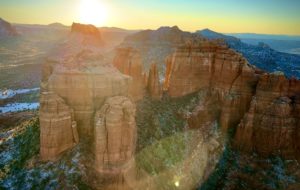This post may contain affiliate links which means we may receive a commission for purchases made through links. As an Amazon Associate we earn from qualifying purchases. We will only recommend products that we have personally used!
As a full-time RV traveler and vlogger, I have spent a considerable amount of time exploring some of the most beautiful and awe-inspiring destinations in the United States. Whether it’s the sweeping vistas of Yellowstone National Park, the amazing red rocks of Devil’s Bridge in the Coconino National Forest, or the rugged wilderness of Joshua Tree National Park, these natural wonders have captivated my imagination and inspired me to share my experiences with others.
However, as I have come to learn, filming in these protected areas is not as simple as one might think. The National Park Service, along with other federal land management agencies, requires a permit for any commercial filming, which includes the production of content intended for public exhibition on digital platforms such as YouTube, TikTok, and Instagram. This requirement applies to all Federal Lands, including National Parks, National Monuments, BLM (Bureau of Land Management) land, and National Forests.
While these regulations have been in place for some time, they are not without controversy. Many vloggers and content creators feel that these requirements limit their ability to share the beauty of our public lands with others and stifle creativity.
One of the issues with these filming permits is that any posting to YouTube or TikTok is often considered commercial filming, even if the creator does not monetize their content. This means that anyone who films in a national park, national monument, BLM land, or national forest and posts their content online must obtain a permit. These permits can be costly and require extensive planning, which can limit the ability of content creators to produce high-quality content.
 The National Park Service and other federal land management agencies have stated that these regulations are necessary to protect the natural and cultural resources of our public lands. Filming activities can disturb wildlife, damage fragile ecosystems, and disrupt other visitors. Additionally, the service has argued that the permits help to maintain the integrity of the public lands and ensure that filming activities do not interfere with other land management operations.
The National Park Service and other federal land management agencies have stated that these regulations are necessary to protect the natural and cultural resources of our public lands. Filming activities can disturb wildlife, damage fragile ecosystems, and disrupt other visitors. Additionally, the service has argued that the permits help to maintain the integrity of the public lands and ensure that filming activities do not interfere with other land management operations.
However, the restrictions on filming in these public lands have come under fire from the content creation community, including vloggers, YouTubers, and influencers. Many creators believe that these regulations unfairly limit their ability to produce content and showcase the beauty of our public lands to the world. The public lands are some of the most beautiful and awe-inspiring destinations in the United States, and creators want to share their experiences with others. They argue that their content can serve as a vital source of inspiration for others to explore and experience the public lands for themselves.This is where our collective action comes into play. By working together, we can push for change and help create a more accessible and inclusive public lands system. In my previous YouTube video, I provided sample letters that can be downloaded and sent to US Senators and Representatives. These letters urge elected officials to reconsider the National Park Service and other federal land management agencies’ position on requiring permits for filming activities.
Since then, I have received an overwhelming response from viewers who have taken the time to download the letters and share them with their elected officials. Thanks to your support and action, there has been new information about the National Park Service’s plans to revisit their filming regulations. This is a significant step forward and a testament to the power of collective action.
However, there is still work to be done. It is important to note that the need for filming permits extends beyond just National Parks to all Federal Lands, including National Monuments, BLM land, and National Forests. It is essential to keep the momentum going and continue to advocate for change. We must ensure that our public lands remain accessible and inclusive for all, including content creators who wish to share their experiences with the world.
In conclusion, it is clear that the regulations surrounding filming activities in our public lands limit our ability to produce content and showcase the beauty of these natural wonders to the world. While there are valid concerns about the impact of filming activities on these delicate ecosystems, it is important to strike a balance between protection and accessibility. We must continue to push for change and advocate for a more inclusive public lands system that supports content creators and allows them to share their experiences with others. By working together, we can help ensure that our public lands remain accessible to all and continue to inspire generations to come.

